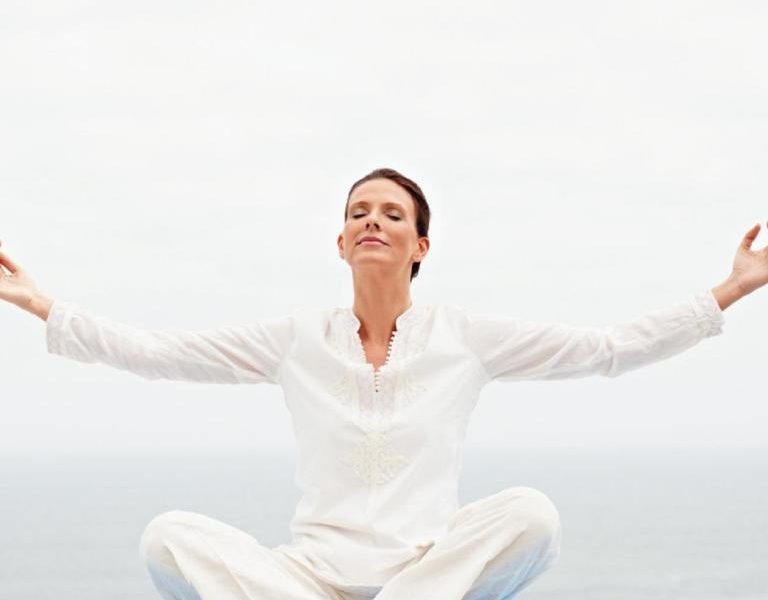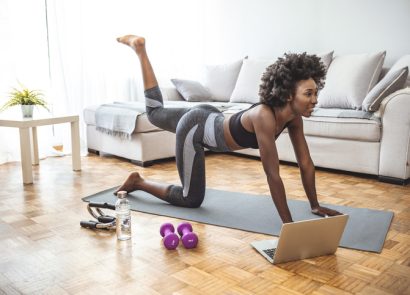Menstruation
Track your cycle
“People often just think about the menstruation part of their cycle, but in fact there are natural hormone fluctuations throughout, which in some women can cause up to 150 PMS symptoms,” says registered nutritional therapist Angelique Panagos (angeliquepanagos.com), author of The Balance Plan – Six Steps to Optimise your Hormonal Health. “The follicular phase starts with menstruation and low sex hormones, so you might have a dip in energy and cramps. In the ovulatory phase, more oestrogen and testosterone is produced as you head for ovulation, which triggers feelings of confidence and energy. In the luteal phase, progesterone is released (and drops if you are not pregnant) so you can get PMS. Keeping a diary or using a period tracker will help you be more mindful of these fluctuations. Plan ahead and optimise your ‘best’ days, so you can go for that job, or do something challenging, on those days when you feel totally ‘on it’, and map out rest days when your hormones are naturally low.”
Meditate on your menstruation
Fed up with cramps? Think yourself better! Regular meditation can change the way you think about period pain and PMS symptoms, such as water retention, and help reduce them, according to a study published in the journal Mindfulness.
Seed cycle
“Seed cycling is based on eating certain nutrients, usually from seeds, at different times of your cycle. These can naturally boost oestrogen in the first half of the cycle and up progesterone during the second half,” says Angelique. “Try having one tablespoon of ground flaxseed and pumpkin seed in the first half of the cycle, and one tablespoon of ground sesame and sunflower in the second half and see if they help to reduce symptoms such as mood swings, headaches and breast tenderness.”
Try acupuncture
The intensity and duration of period pain has been shown to be reduced by as much as 50 percent in women who had manual acupuncture. The Australian study found that the more treatments the women underwent, the better the results seemed to be. Find your local practitioner via acupuncture.org.uk.
Eat mindfully
One of the ways the body gets rid of excess oestrogen produced by the liver is through the digestive system. However, if digestion is sluggish oestrogen can be reabsorbed into the bloodstream rather than excreted through the bowel, causing hormonal imbalances.
“While eating at our desks might seem like brilliant multitasking, if you’re stressed, blood is diverted away from the digestive tract causing food to sit there for longer, leading to bloating,” says Angelique. “Instead, take 30 minutes to eat your meal and switch off distractions. Really think about how the food looks, tastes, smells.”
Do some cardio (But stretch afterwards!)
“Cardio exercises not only boost energy, they improve blood flow to muscles and joints and release endorphins, which helps boost mood and relieve cramps,” says personal trainer Laura Williams (laurawilliamsonline.co.uk). “Stretches such as the child’s pose offer increased range of movement in the pelvic area, while the reclined goddess pose helps to deeply stretch the groin.”
Get a massage
“Most menstrual problems such as menstrual pain and irregular cycles are related to problems within the kidney meridian,” says Chinese medicine practitioner Alex Wu, author of A User’s Manual for the Human Body: How Traditional Chinese Medicine helps the body (released January 29th 2019). “In the short term, there are several meridian points that can be massaged daily to improve the fluidity of the kidney meridian.” Watch a video tutorial at bit.ly/TraditionalChineseMedicineMassageVideo
Perimenopause
Hypnotise your hot flushes
Perimenopause can begin eight to 10 years before the menopause and, as the ovaries gradually produce less oestrogen, many women experience hot flushes, memory loss, energy dips and poor sleep. “Self hypnosis or visualisations can help you let go of tension,” says integrative hypnotherapist, life coach and occupational psychologist Jivan Dempsey (jivandempsey.com). “Allow yourself to enter a self-induced trance with some deep breathing and then think about your favourite place – a holiday destination, the countryside, wherever you feel really, really safe, and let go. Make this a routine you tap into when you feel a hot flush coming on – the symptoms will be less severe as your brain is focused on positivity and not the symptoms.”
Take mindful breaks
“Studies have shown there is a 50 percent reduction in hot flushes after just 30 minutes of formal relaxation every day,” says natural menopause pioneer Maryon Stewart (maryonstewart.com), author of the Natural Menopause Plan. “Try to take a 10-minute break every hour and mix it up – listen to music, write in a gratitude journal, or try an affirmation. These are positive phrases such as ‘I am grateful for my health’ or ‘I love to look after my body and mind’ which you can repeat to yourself to describe how you want to be. Positive affirmations like these have been shown to calm the mind, help with bodily symptoms, and become self-fulfilling.”
Deep breathing
“Deep belly breathing can reduce stress hormones such as adrenaline and cortisol, which in high doses can make us feel anxious,” says Angelique. “Try 4/7 breathing – with one hand on the chest and one on the abdomen, take a deep breath to the count of four, feeling your belly expand. Pause and breathe out for a count of seven, feeling your belly contract, and repeat 10 times.”
Plan a short, sweet workout
Getting sweaty might be the last thing you feel like doing when you’re experiencing perimenopause symptoms but research suggests high intensity interval training (HIIT) exercise (short and intense intervals of movement teamed with brief recovery periods) not only gives you an endorphin rush (great for mood swings) and boosts metabolism (ideal for burning that menopausal belly fat), but can also help with hot flushes. “It’s thought this kind of exercise helps lower core body temperature and increases the body’s mechanism for dissipating heat,” affirms Williams.
Menopause
Reframe menopause
“It’s really helpful to reframe the values, beliefs and identity that may be held around this ‘loss of youth’ or ‘fertility’ and ‘usefulness’,” says Dempsey. “According to the American Physiological Society, cognitive behavioural therapy (CBT) can help you put the symptoms of menopause in to perspective, seeing it as a natural phase of life and not a disorder or disease. This can make a significant difference to the emotional side of the menopause, which is a rollercoaster of emotions at the best of times.”
Go for a walk
In a recent study of 60,000 postmenopausal women, brisk walking four times a week resulted in a lower risk of hip fractures – but it can also have benefits for wellbeing, too. “When we walk outside, we breathe more deeply and this calms the body, which is extremely beneficial to the thyroid, which can help control our hormones,” says Angelique.
Take the flax
“After menopause the adrenal glands (and fat cells) take over the job of producing oestrogen, and low levels can lead to decreased energy, libido and mood. Adding plant-based phyto-oestrogens to your diet, found in oats, soy, nuts, legumes and ground flaxseeds, has been shown to help balance hormones,” says Angelique.
Resist the urge to over-train
Rather than doing the exercise you’ve always done, change it to short and sweet workouts that burn fat and build muscle (without releasing cortisol), triggering the release of our natural human growth hormones (HGH). Strength training in particular, whether that’s lifting weights or just using your body weight as resistance in a Pilates class, has been shown to offset the decline of bone mineral density and collagen loss, plus prevent osteoporosis.
Try yoga for libido
The physiological and psychological changes surrounding the menopause can affect sex drive and arousal – but yoga can help. “A yoga tantric pose can relax your system and encourage the release of oxytocin, the pleasure hormone,” suggests yoga teacher Julia Davis in The Menopause Exchange newsletter (menopause-exchange.co.uk), which provides impartial and practical information on the menopause. “Sit in a comfortable position with your left hand over your heart and right hand over your uterus, then breathe into your heart and out to your uterus for a number of breaths. It can be very healing. The mountain pose and bridge pose can also be the foundation for strengthening muscles that support continence and the lower abdomen.”





















